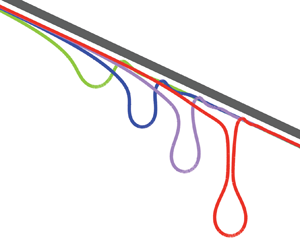Article contents
Dripping instability of a two-dimensional liquid film under an inclined plate
Published online by Cambridge University Press: 15 December 2021
Abstract

It is known that the dripping of a liquid film on the underside of a plate can be suppressed by tilting the plate so as to cause a sufficiently strong flow. This paper uses two-dimensional numerical simulations in a closed-flow framework to study several aspects of this phenomenon. It is shown that, in quasi-equilibrium conditions, the onset of dripping is closely associated with the curvature of the wave crests approaching a well-defined maximum value. When dynamic effects become significant, this connection between curvature and dripping weakens, although the critical curvature remains a useful reference point as it is intimately related to the short length scales promoted by the Rayleigh–Taylor instability. In the absence of flow, when the film is on the underside of a horizontal plate, the concept of a limit curvature is relevant only for small liquid volumes close to a critical value. Otherwise, the drops that form have a smaller curvature and a large volume. The paper also illustrates the peculiarly strong dependence of the dripping transition on the initial conditions of the simulations. This feature prevents the development of phase maps dependent only on the governing parameters (Reynolds number, Bond number, etc.) similar to those available for film flow on the upper side of an inclined plate.
Information
- Type
- JFM Papers
- Information
- Copyright
- © The Author(s), 2021. Published by Cambridge University Press
References
REFERENCES
Zhou and Prosperetti supplementary movie 1
This movie shows the evolution of the wave shape (two periods) for the $135^\circ$ case of figure 8 in the paper. In the top panel, the scale in the normal direction is enlarged 6 times with respect to the horizontal scale, which permits a clearer view of the generation and absorption of the small disturbance in front of the main hump. The bottom panel is plotted using the same length unit for both directions. Here $Re_\perp=50$, $Bo_\perp=0.6$, $V/h_0^2=40$.
Zhou and Prosperetti supplementary movie 2
This movie shows animations of two cases illustrated in figure 17(b), in which the gravity component normal to the plate is restored at $ \sqrt{g/h_0}\,t=10$ (red) and $ \sqrt{g/h_0}\,t=15$ (blue). In the former case, the dripping instability has sufficient time to develop and ultimately (two-dimensional) drops form. For the latter case, the Kapitza instability develops before the dripping instability and the film remains stable. Two wave periods are shown. Note the arrows in the lower right corner of the image, which indicate the gravity components acting on the film at the time of each frame. Initially, for both simulations, only the component parallel to the plate acts. The normal component is then restored, first for the red wave and later for the blue wave. Here $Re_\perp=50$, $Bo_\perp=0.6$, $V/h_0^2=40$.
- 8
- Cited by


